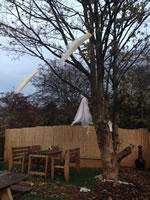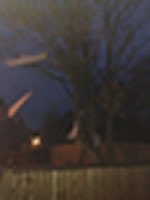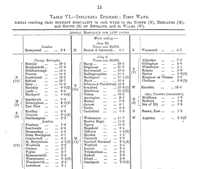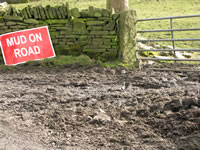October 2014
Hallowe'en
31/10/14 22:48
I am not a great fan of Hallowe’en. Over my lifetime it has passed from bobbing apples and apples on string through trick or treating and ghosts to an emphasis on horror.
Marl Pits held the ‘run of the living dead’ on Sat 26th Oct in which people paid £50 for the privilege of running 5k through the mud whilst avoiding zombie challenges and men in military uniform bearing replica guns. I run up there most days for free for the privilege of being chased by the odd cow… Sadly the organisers didn’t ensure that non-participating families didn’t meet any zombies inadvertently or clean up after themselves afterwards. Ah well.
The Red Lion in Higher Cloughfold held its first children’s hallowe’en party on 31st Oct with what must surely be the most pathetic ghosts ever:

and they didn’t look much better at night either.

There is a lot of misconception about hallowe’en. It has no pagan origins and was not associated with spirits, ghosts or witches until modern times - mainly last century. These misconceptions are explained in this article from BBC History. Another good description is given in ‘Stations of the Sun’ by Ronald Hutton, himself a pagan but debunking a lot of the ‘pagan prehistory’ myths of hallowe’en and other rituals.
A more positive alternative is offered by one of the churches which puts on a fun party for children without a zombie in sight.
Marl Pits held the ‘run of the living dead’ on Sat 26th Oct in which people paid £50 for the privilege of running 5k through the mud whilst avoiding zombie challenges and men in military uniform bearing replica guns. I run up there most days for free for the privilege of being chased by the odd cow… Sadly the organisers didn’t ensure that non-participating families didn’t meet any zombies inadvertently or clean up after themselves afterwards. Ah well.
The Red Lion in Higher Cloughfold held its first children’s hallowe’en party on 31st Oct with what must surely be the most pathetic ghosts ever:

and they didn’t look much better at night either.

There is a lot of misconception about hallowe’en. It has no pagan origins and was not associated with spirits, ghosts or witches until modern times - mainly last century. These misconceptions are explained in this article from BBC History. Another good description is given in ‘Stations of the Sun’ by Ronald Hutton, himself a pagan but debunking a lot of the ‘pagan prehistory’ myths of hallowe’en and other rituals.
A more positive alternative is offered by one of the churches which puts on a fun party for children without a zombie in sight.
conference season
25/10/14 22:54
Being an introvert I sometimes find rooms of strangers somewhat daunting so it was with a degree of trepidation that I booked not one but two history conferences within 10 days. I needn’t have worried as one place studies people and community historians are a friendly and welcoming lot.
The first trip out was to Chorley for the Community Archives and Heritage Group North West Regional conference. After a warm welcome from His Worship we settled down to an enticing series of presentations outlining the help available from the Record Office and Museum conservation service and similar bodies. This was much more extensive than I appreciated and if anyone needs to borrow an eagle owl or hedgehog (stuffed) to illustrate their displays then the Museum is happy to oblige. There are even rumours of the availability of a polar bear but getting him a genuine Springhill connection may be tricky.
There was rapt attention for the lady who was explaining how to get money out of the heritage lottery fund. Interestingly the number of people who had applied for cash greatly outweighed those who had ever played the lottery to help put the money in...
My second jaunt was today to the Society of One-Place Studies inaugural conference. This had a focus on WW1 - local resources, local impact, local remembrances and involving local people in researching. There was an emphasis on lesser known resources and on asking questions beyond the obvious. The construction and siting of war memorials involved much more politics than I had previously appreciated and I will have to do a bit of poking around to look as some of the who’s and why’s behind some of the memorials in this area. Lots of interesting snippets with no known local relevance but still fun, like the 44,000 war horses sold to the French for meat and the image of soldiers writing to members of a knitting guild to thank them for the socks like children writing Christmas letters.
The common message from both events was the importance of preserving and sharing records and involving future generations.
One problem now - so many ideas and so little time...
The first trip out was to Chorley for the Community Archives and Heritage Group North West Regional conference. After a warm welcome from His Worship we settled down to an enticing series of presentations outlining the help available from the Record Office and Museum conservation service and similar bodies. This was much more extensive than I appreciated and if anyone needs to borrow an eagle owl or hedgehog (stuffed) to illustrate their displays then the Museum is happy to oblige. There are even rumours of the availability of a polar bear but getting him a genuine Springhill connection may be tricky.
There was rapt attention for the lady who was explaining how to get money out of the heritage lottery fund. Interestingly the number of people who had applied for cash greatly outweighed those who had ever played the lottery to help put the money in...
My second jaunt was today to the Society of One-Place Studies inaugural conference. This had a focus on WW1 - local resources, local impact, local remembrances and involving local people in researching. There was an emphasis on lesser known resources and on asking questions beyond the obvious. The construction and siting of war memorials involved much more politics than I had previously appreciated and I will have to do a bit of poking around to look as some of the who’s and why’s behind some of the memorials in this area. Lots of interesting snippets with no known local relevance but still fun, like the 44,000 war horses sold to the French for meat and the image of soldiers writing to members of a knitting guild to thank them for the socks like children writing Christmas letters.
The common message from both events was the importance of preserving and sharing records and involving future generations.
One problem now - so many ideas and so little time...
why did it start here?
16/10/14 22:18
I was browsing around on histpop tonight looking for anything of interest and clicked on the supplement to the Registrar-General’s 81st report. As you do. This was a supplement reporting on the mortality from influenza in England and Wales in 1918-19, the ‘Spanish flu’ epidemic.
What I hadn’t realised before this was that amongst the earliest reports of flu related mortality were those from Bacup and Rawtenstall. The R-G does say that they cannot be certain that flu started its UK epidemic in these places as there were sporadic outbreaks roughly simultaneously indifferent parts of the country. What is clear however is that of the week ending June 29 1918 the highest mortality was returned from Bacup (33/1000) and the third highest from Rawtenstall (half as bad as Bacup at 18/1000) with Bacup in particular being miles ahead of anywhere else.

Bacup is 5 miles east of Springhill and Rawtenstall just less than a mile to the west, to this area was going to be affected, if only by fear. Interestingly whilst Bacup and Rawtenstall were severely affected, Whitworth and Haslingden, adjacent towns, escaped relatively lightly.
Spanish flu came in three waves; Bacup and Rawtenstall were relatively little affected by these subsequent waves. Presumably everyone had either died or become immune with sufficient herd immunity to prevent the virus from re-establishing itself.
Spanish flu is caused by H1N1 flu virus, more recently of swine flu fame. Like swine flu it was more severe in young adults rather than most flu which tends to affect the elderly more severely. There have been a variety of theories as to why this was the case in 1918, with many suggesting that mixing of peoples during WW1 lead to easier spread whilst the stresses of war reduced soldiers’ immunity. It is estimated that 5x more people died in the endemic than died in WW1.
But why here? Sure there were a large number of soldiers, but not more than many places. They did not predominantly join a single regiment or ‘Pals’ brigade. There is no port (40 miles from the sea!) or airport and minimal tourism or business travel. There was poverty and overcrowding, but again no worse than many industrial areas. And why were adjacent areas relatively unaffected?
Am going to have to do some thinking and reading here, and to revise my long-forgotten immunology.
Obituaries of some of the Bacup soldiers to die can be found in these extracts from the Bacup Times.
What I hadn’t realised before this was that amongst the earliest reports of flu related mortality were those from Bacup and Rawtenstall. The R-G does say that they cannot be certain that flu started its UK epidemic in these places as there were sporadic outbreaks roughly simultaneously indifferent parts of the country. What is clear however is that of the week ending June 29 1918 the highest mortality was returned from Bacup (33/1000) and the third highest from Rawtenstall (half as bad as Bacup at 18/1000) with Bacup in particular being miles ahead of anywhere else.

Bacup is 5 miles east of Springhill and Rawtenstall just less than a mile to the west, to this area was going to be affected, if only by fear. Interestingly whilst Bacup and Rawtenstall were severely affected, Whitworth and Haslingden, adjacent towns, escaped relatively lightly.
Spanish flu came in three waves; Bacup and Rawtenstall were relatively little affected by these subsequent waves. Presumably everyone had either died or become immune with sufficient herd immunity to prevent the virus from re-establishing itself.
Spanish flu is caused by H1N1 flu virus, more recently of swine flu fame. Like swine flu it was more severe in young adults rather than most flu which tends to affect the elderly more severely. There have been a variety of theories as to why this was the case in 1918, with many suggesting that mixing of peoples during WW1 lead to easier spread whilst the stresses of war reduced soldiers’ immunity. It is estimated that 5x more people died in the endemic than died in WW1.
But why here? Sure there were a large number of soldiers, but not more than many places. They did not predominantly join a single regiment or ‘Pals’ brigade. There is no port (40 miles from the sea!) or airport and minimal tourism or business travel. There was poverty and overcrowding, but again no worse than many industrial areas. And why were adjacent areas relatively unaffected?
Am going to have to do some thinking and reading here, and to revise my long-forgotten immunology.
Obituaries of some of the Bacup soldiers to die can be found in these extracts from the Bacup Times.
the blindingly obvious
09/10/14 22:28
We know that there are obligations on landowners to inform people about things which may affect their safety or wellbeing, but sometimes it can lead to their stating the blindingly obvious...






